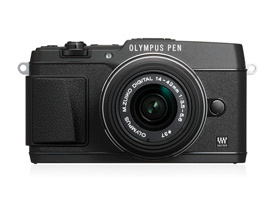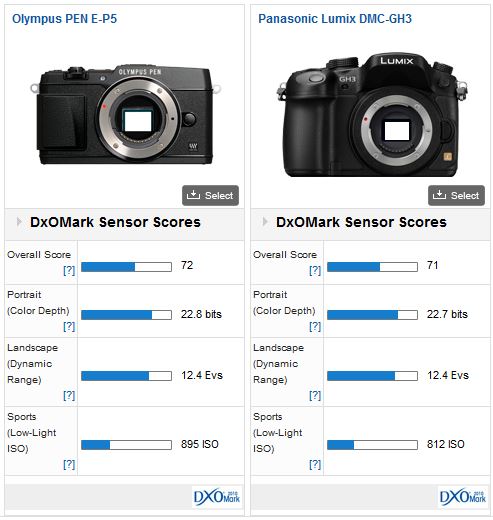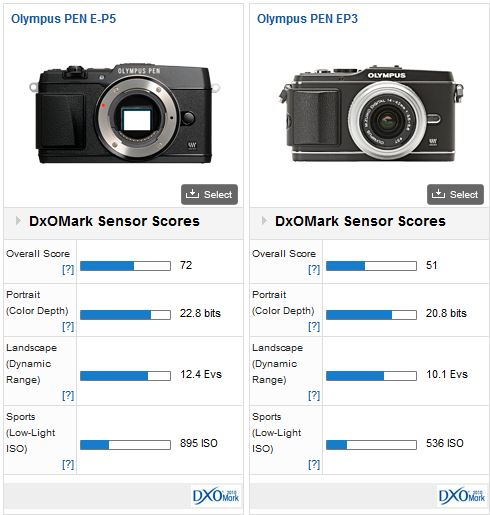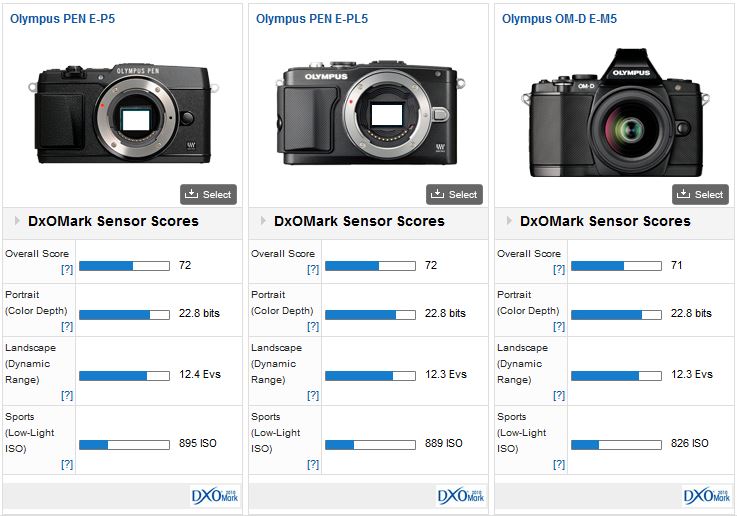Introduction
Last year saw the introduction of the Olympus O-MD E-M5, with a nod to firm’s film-era cameras but packing an new 16-Mpix MOS type sensor on an advanced ‘5-axis’ stabilized platform, built-in EVF, weatherproofing, high speed AF and 9fps continuous shooting, it became a sensation practically overnight. The new $999 (body only) E-P5 looks to capitalize on that using the familiar PEN body shape instead and by adding a sprinkling of promising new features, including focus ‘peaking’,1/8000 sec top shutter speed (and 1/320 sec flash sync), built-in intervalometer and time lapse movie creation option, as well as Wi-Fi for remote shooting and image transfer to a smartphone or tablet. Although the E-P5 lacks a viewfinder, it has a 1.04m dot 3-inch LCD touchscreen display with tilting mechanism, the firm also announced a new optional finder for it. Although an extra $279, the VF-4 has a new 2.36M dot LCD, proximity sensor and 1.48x (0.74 equivalent) magnification.
A DxOMark Sensor score of 72 points is one of the best scores from a MFT camera, and in our rankings comes 61 just ahead of some recent APS-C models such as the Samsung NX210 and Canon EOS 100D /SL1 but just behind some of the best of the older APS-C models such as the Pentax K-r and K-x. With the Color Depth at 22.8 bits and a Dynamic range of 12.4 Evs, that’s a great performance against a sensor that’s around 65% larger by surface area. The one area where MFT sensors generally concede some capability to the best APS-C CMOS sensors is in their low-light performance, where the E-P5 achieves a low-ish score. That said, the E-P5 can still out-perform some APS-C models in that regard, such as the Canon EOS 700D / Rebel T5i, for example, which achieved a 681 ISO rating in our recent tests.
Olympus PEN E-P5 Versus Panasonic Lumix DMC-GH3:
Against the top of the range $1,299 (body only) Panasonic Lumix DMC-GH3, the E-P5 achieves practically identical scores for each use case, it strongly suggests that the two models share the same sensor unit, albeit with the Olympus showing some slight improvement (less 1/3 stop) in low-light performance.
Olympus PEN E-P5 Versus Olympus PEN EP3:
Even with an increase in pixel count (up from 12.3-Mpix to 16.1-Mpix) the E-P5 shows a substantial increase in imaging performance against the firm’s older PEN E-P3 model. At base ISO, the new sensor shows an improvement of +1.3 stop in color depth, a healthy +0.7 stop gain in low light and impressive +2.3 stops wider dynamic range.
Olympus PEN E-P5 Versus Olympus PEN E-PL5 Versus Olympus OM-D E-M5:
If you’ve been following our reviews of the PEN E-PL5 and OM-D E-M5 you’ll know that the two appear to share the same sensor and from the results of the E-P5 it appears Olympus is using the same unit again, albeit with some slight optimization of low-light performance.While the sensor is a proven performer, it is perhaps slightly disappointing that the firm hasn’t chosen the flagship PEN to showcase something new.
As the new top of the range PEN, the E-P5 has a good balance of features, best build of any PEN models to date and the best performing MFT sensor currently available. However, models such as the Nikon D7100, which adopts a new sensor, and, to a lesser extent, the Ricoh GR and Nikon Coolpix A, with their older sensors,all out-perform the E-P5 in low light. With the market moving towards smaller, highly portable cameras featuring APS-C format sensors, Olympus needs to constantly reassert the advantages of the MFT format.










DXOMARK encourages its readers to share comments on the articles. To read or post comments, Disqus cookies are required. Change your Cookies Preferences and read more about our Comment Policy.